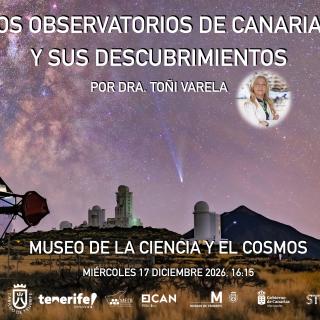It may interest you
-
 El Instituto de Astrofísica de Canarias (IAC) inaugura este miércoles 17 de diciembre una nueva edición del ciclo "Cosmoviaje 2.0. Lo que sabemos e ignoramos del Universo" y lo hará de la mano de la investigadora y directora del Museo de la Ciencia y el Cosmos Antonia Varela quien impartirá su charla " Observatorios de Canarias y sus descubrimientos" a las 16:15 horas. La entrada será libre y gratuita hasta llenar el aforo. Una experta de referencia en astrofísica y divulgación Antonia Varela es doctora en Astrofísica e investigadora del IAC, donde forma parte del Grupo de Calidad de Cielo yAdvertised on
El Instituto de Astrofísica de Canarias (IAC) inaugura este miércoles 17 de diciembre una nueva edición del ciclo "Cosmoviaje 2.0. Lo que sabemos e ignoramos del Universo" y lo hará de la mano de la investigadora y directora del Museo de la Ciencia y el Cosmos Antonia Varela quien impartirá su charla " Observatorios de Canarias y sus descubrimientos" a las 16:15 horas. La entrada será libre y gratuita hasta llenar el aforo. Una experta de referencia en astrofísica y divulgación Antonia Varela es doctora en Astrofísica e investigadora del IAC, donde forma parte del Grupo de Calidad de Cielo yAdvertised on -
 An international scientific team, including members of the Instituto de Astrofísica de Canarias (IAC), has launched an ambitious program to map exoplanets located around the Neptunian Desert —a region around stars where planets the size of Neptune are very rare— in order to better understand the mechanisms of planetary system evolution and formation. This scientific expedition has delivered its first results with the observation of the TOI-421 planetary system. Analysis of this system reveals a surprisingly inclined orbital architecture, offering new insights into the chaotic history ofAdvertised on
An international scientific team, including members of the Instituto de Astrofísica de Canarias (IAC), has launched an ambitious program to map exoplanets located around the Neptunian Desert —a region around stars where planets the size of Neptune are very rare— in order to better understand the mechanisms of planetary system evolution and formation. This scientific expedition has delivered its first results with the observation of the TOI-421 planetary system. Analysis of this system reveals a surprisingly inclined orbital architecture, offering new insights into the chaotic history ofAdvertised on -
Dr. Rubén Sánchez-Janssen has been announced as the new Director of the Isaac Newton Group of Telescopes (ING). Dr. Rubén Sánchez-Janssen will follow in the footsteps of Dr. Marc Balcells. Dr Sánchez-Janssen is an Astronomer and Project Scientist at STFC’s UK Astronomy Technology Centre (UKATC), where he leads the development of scientific instrumentation and facilities for ground- and space-based astronomy from the ultraviolet to the near-infrared, with a particular emphasis on future missions. He specializes in galaxy evolution, with particular focus on low-mass galaxies and star clusterAdvertised on

